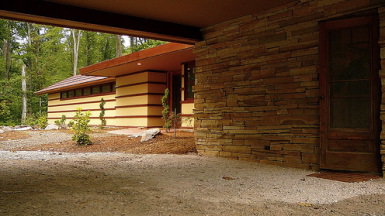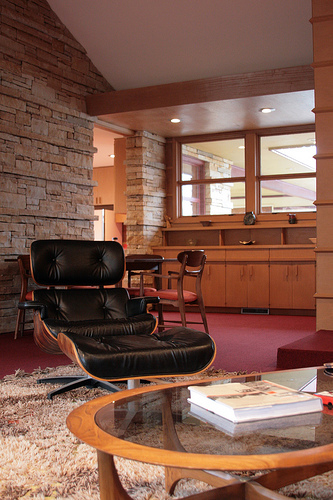Having been put through the wringer by an unexpected siege of illness, Mrs. T and I were profoundly grateful when the doctors cut her loose two weeks ago and gave their blessing to our long-planned, much-needed vacation. I was so careworn that I succumbed to a case of stress-related bronchitis a day or two before we hit the road, but I managed to enjoy myself anyway and got enough rest to shake it off well before the clock ran out.
We made three stops along the way:
 • As part of our long-term project of staying at all six of the Frank Lloyd Wright houses that can be rented for overnight stays, we launched our vacation by flying to Pittsburgh and driving from there to Polymath Park, the rural resort to which Wright’s Duncan House, which was previously to be found in Illinois, was moved in 2002, just ahead of the wrecker’s ball.
• As part of our long-term project of staying at all six of the Frank Lloyd Wright houses that can be rented for overnight stays, we launched our vacation by flying to Pittsburgh and driving from there to Polymath Park, the rural resort to which Wright’s Duncan House, which was previously to be found in Illinois, was moved in 2002, just ahead of the wrecker’s ball.
The Duncan house is one of a group of prefabricated houses designed by Wright and manufactured by Marshall Erdman that were built in the Fifties. (Another Wright prefab is located in Staten Island.) It’s the only one open to the public, so this was our first chance to get a look at what Wright had in mind when in 1955 he started to design a house that, unlike any of his earlier residences, would be suitable for mass construction.
 Most of the Erdman prefabs are single-story ranch-style houses that range in size from 1,860 to 2,400 square feet. When you bought one, you got the house itself: walls, floors, windows, doors, cabinets, woodwork. You supplied the lot and foundation, plus plumbing, heating, wiring, paint, and labor. Unlike the custom-designed Usonian houses that were Wright’s first full-scale attempt at creating housing for the American middle class, the Erdman prefabs have very simple interiors that lack the arrestingly elegant detail of the other Wright houses in which Mrs. T and I have stayed. This, however, makes it possible to see the spine of the architectural design more clearly, and in so doing to realize just how much it contributes to the house’s total effect. Time and again I’ve found that it’s restful to spend the night in a Wright house. The interiors are so spacious and uncluttered, and so perfectly integrated with their outdoor surroundings, that they create an uncanny feeling of tranquility in their occupants. The Duncan House is no exception: if you don’t sleep well there, you won’t sleep well anywhere.
Most of the Erdman prefabs are single-story ranch-style houses that range in size from 1,860 to 2,400 square feet. When you bought one, you got the house itself: walls, floors, windows, doors, cabinets, woodwork. You supplied the lot and foundation, plus plumbing, heating, wiring, paint, and labor. Unlike the custom-designed Usonian houses that were Wright’s first full-scale attempt at creating housing for the American middle class, the Erdman prefabs have very simple interiors that lack the arrestingly elegant detail of the other Wright houses in which Mrs. T and I have stayed. This, however, makes it possible to see the spine of the architectural design more clearly, and in so doing to realize just how much it contributes to the house’s total effect. Time and again I’ve found that it’s restful to spend the night in a Wright house. The interiors are so spacious and uncluttered, and so perfectly integrated with their outdoor surroundings, that they create an uncanny feeling of tranquility in their occupants. The Duncan House is no exception: if you don’t sleep well there, you won’t sleep well anywhere.
The Erdman prefabs, which were originally intended to sell for $15,000, should have taken American homebuyers by storm. But like so many of Wright’s projects, they ended up costing far more than expected. The turnkey cost of a Wright prefab was roughly fifty thousand dollars, the equivalent of $377,000 today, and some cost far more than that. (The total cost of the Wright prefab on Staten Island, including lot, installation charges, and “extras,” was $100,000 in 1957 dollars.) As a result, the enlightened-but-not-wealthy people to whom Erdman pitched them failed to materialize, and only eleven were built. Fortunately, all eleven prefabs are still standing, and anyone with a serious interest in Wright’s work should make every effort to spend a couple of nights in this one.
Nearly everyone who stays in Duncan House does so in order to tour Fallingwater, which is thirty miles away. Needless to say, Mrs. T and I did so as well, she for the second time and I for the third, and we found the experience as engrossing as ever. I blogged at length about Fallingwater in 2003, so this time around I’ll simply say that the more often you visit the house, the more powerful is its attraction. I wish I could go there four times a year and spend a whole day each time.
(First of two parts)
